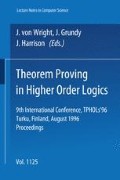Abstract
This paper reports on work to alleviate the problem that high-level synthesis tools cannot in general produce results that are comparable in quality to manual design. We propose to use pre-synthesis transformations of algorithmic input specifications to improve the quality of the synthesis. By mechanising transformational reasoning about specifications as interactive theorem-proving in a proof system no errors are introduced during transformation, the designer can guide the tuning process and we can make behavioural transformations which extend the capabilities of the synthesis tool.
This work was done while the author was at Linköping University, Sweden
Preview
Unable to display preview. Download preview PDF.
References
R. Boulton. A HOL Semantics for a Subset of ELLA. Technical Report 254, University of Cambridge, Computer Laboratory, New Museums Site, Pembroke Street, Cambridge CB2 3QG, England, Apr. 1992.
J. Camilleri and T.Melham. Reasoning with Inductively Defined Relations in the HOL Theorem Prover. Technical Report 265, University of Cambridge, Computer Laboratory, Aug. 1992.
Proceedings of the 1991 International Workshop on Formal Methods in VLSI Design, Miami, Jan. 1991.
A. D. Gordon. Transformational Design using a Proof Assistant. Oct. 1992.
A. D. Gordon. A Mechanised Definition of Silage in HOL. Technical Report 287, University of Cambridge, Computer Laboratory, Feb. 1993. ESPRIT BRA 3215.
E. Gunter. The nested_rec contrib library. HOL 90.7 Documentation, 1994. Available with the HOL 90.7 release.
S. D. Johnson and B. Bose. DDD — A System for Mechanized Digital System Design Derivation. In Formal Methods in VLSI Design [3].
M. C. McFarland and A. C. Parker. An Abstract Model of Behavior for Hardware descriptions. IEEE Transactions on Computers, C-32(7):621–637, July 1983.
Z. Peng and K. Kuchcinski. Automated Transformation of Algorithms into Register-Transfer Level Implementations. IEEE Transactions on Computer-Aided Design of Integrated Circuits and Systems, 13(2):150–166, Feb. 1994.
Author information
Authors and Affiliations
Editor information
Rights and permissions
Copyright information
© 1996 Springer-Verlag Berlin Heidelberg
About this paper
Cite this paper
Larsson, M. (1996). Improving the result of high-level synthesis using interactive transformational design. In: Goos, G., Hartmanis, J., van Leeuwen, J., von Wright, J., Grundy, J., Harrison, J. (eds) Theorem Proving in Higher Order Logics. TPHOLs 1996. Lecture Notes in Computer Science, vol 1125. Springer, Berlin, Heidelberg. https://doi.org/10.1007/BFb0105412
Download citation
DOI: https://doi.org/10.1007/BFb0105412
Published:
Publisher Name: Springer, Berlin, Heidelberg
Print ISBN: 978-3-540-61587-3
Online ISBN: 978-3-540-70641-0
eBook Packages: Springer Book Archive

